 |
| A
Syriac shepherd on guard near his flock. (photo: Karen Lagerquist) |
“We lived in terror” is how
a Syriac Christian villager in the Tur Abdin region of southeast Turkey
described life there for the last 16 years – years spent caught in the
middle of a dogged guerrilla civil war between Turkish military forces and
the secessionist Kurdistan Workers Party (PKK).
This conflict threatens to
empty the Syriac Christian heartland and is one more case of the pressure
on Christians to leave Turkey. Memories of the massacre of 1.5 million
Armenians in Turkey in the early 20th century and the violence unleashed
against Greeks in Istanbul in September 1955 are fresh enough to inspire
Tur Abdin’s Christians to flee.
Tur Abdin’s once vital
Syriac Christian population of about 80,000 has fallen to about 2,500. Yet,
to those Syriac Christians who remain in Tur Abdin (Syriac for “Mountain
of the Servants of God”), the arid mountainous land between the Tigris
River and the Syrian border is their holy land. Christianity there dates
to the early first century and to this day Syriac Christians celebrate
liturgies in Turoyo – a dialect of Aramaic, the language used by Jesus
Christ and the apostles.
A cease-fire between the
Turkish govern-ment and the Kurds means conditions in the region are
slowly improving. Fighting dropped off sharply since the 1999 capture of
PKK commander Abdullah Ocalan, who ordered his followers to withdraw from
Turkey into northern Iraq.
The PKK has changed its
strategy and says it wants to campaign peacefully for the rights of Kurds
and has dropped the demand to establish an independent Kurdistan. In 2002,
it changed its name to the Congress for Freedom and Democracy in Kurdistan
(KADEK). However, the move has been dismissed as a sham by the Turkish
authorities; the European Union has placed it on its list of terrorist
groups.
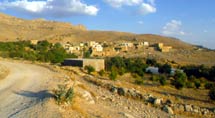 |
|
Binyamin is a Syriac mountain village. (photo: Karen Lagerquist) |
With the help of an economic
recovery program, dirt roads have been paved and the number of bus routes
into area villages has increased.
Virtually all military
checkpoints have been removed and freedom to travel has returned. The
spin-off to these improvements is that the tourist industry has been
revived and new hotels, restaurants and even Internet cafes have opened.
Turkey has applied for
European Union membership, but the EU says Turkey still needs to improve
its political and human rights record and to reform its oppressive
minority laws before the country can be admitted.
In the decades following
World War I, many of the region’s churches fell into disrepair, becoming
unusable. Muslim extremists and local Turkish government officials
hindered restoration efforts often by denying construction permits.
Further restrictions were
imposed on the Syriac Christians after the Lausanne Treaty of 1923, when
the community was not listed as a distinct minority whereas official
status was given to Turkey’s Armenian, Greek and Jewish citizens. For this
reason, the government prohibited Syriac Christians from operating its own
schools and interfered with church administration.
Now suddenly, after decades
of being denied basic rights, the Syriac Church, Catholic and Orthodox, is
permitted to teach freely its own language – a century-old ban that has
threatened the survival of the ancient language.
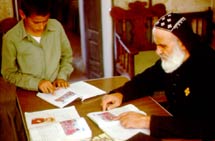 |
| A
Syriac Orthodox monk instructs a village boy in Aramaic. (photo: Chris
Hellier) |
“We have big hopes for the
future because the political climate has changed,” said Father Gabriel
Akyuz of the Syriac village of Hah. “If we are accepted into the EU our
future will be even more secure.”
In Tur Abdin’s two main
cities, Mardin and Midyat, dusty marketplaces are busy with shoppers. Boys
weave through the crowds energetically chasing down scuffed footwear with
offers of a quick shoe shine. Inside the shops, people are bargaining,
buying and selling – a sure sign of the improving economy. The language
shifts from Arabic, Kurdish and Turkish – only the Christians understand
Aramaic, which is used for the liturgies of the church.
Mixed in the crowded streets
are Kurdish women with facial tattoos as well as devout Muslim women in
their all-covering black peces or burkas. Yet each community shares
respect and understanding for the other. They speak the same mix of
languages, shop at the same stores, attend school and play together. The
differences are fewer than the similarities. One 12-year-old Kurdish girl
playing outside a church gate said: “The only difference is that we go to
mosque and they go to church.”
“We have no problems with
Muslims. They are our neighbors, friends, colleagues and students,” a
schoolteacher from Mardin said. She added that her Christianity has never
caused a problem.
But these are not the views
of all Christians from Tur Abdin. Opinions differ, sometimes drastically,
depending on the city or village, or who may be listening.
“We are not free,” said one
church official who spoke on the condition of anonymity. Then he added, “I
am not comfortable talking about these things,” citing a Tur Abdin priest
who, after speaking to a journalist about the 1915 Christian genocide in
Turkey, faced criminal charges.
The hillside city of Midyat
looks down over the valley as a great amphitheater.
Its decorative houses,
crafted by traditional Christian stone carvers, ascend the hillside
step-like – one a little higher than the next. Dome-shaped bell towers and
slim minarets pierce its skyline. But the city’s famed Christian stone
carvers have all left. The Christian population, once a majority, now
numbers some 100 families.
Midyat is also famous for
its tradition of Christian artisans specializing in the fine art of
filigree – fashioning silver wire into jewelry, vases and bowls. With
fewer and fewer Christians to pass on the tradition, it is being taught to
Muslim apprentices. Muslims now own most of the shops surrounding the
city’s central square.
One of the few remaining
Christian shop owners is Gebro Tokgoz. When he was a child, he learned the
silversmith trade from his grandfather. He can only guess how far back the
tradition goes. Mr. Tokgoz hopes to continue it for at least one more
generation with his eldest son.
Conversation inside the shop
shifts between Turkish, Arabic and Kurdish.
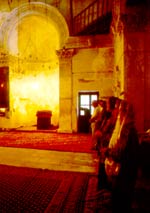 |
|
Faithful gather for liturgy at the Deyrulzafaran Monastery outside
Mardin. (photo: Karen Lagerquist) |
Mr. Tokgoz gets along well
with his Muslim clients and neighbors, including the police who stop in
for tea and a chat. But Mr. Tokgoz is uncomfortable with discussing the
future of Turkey’s Syriac Christians. In fact, the moment the police enter
the shop, any conversation about Christianity comes to an abrupt halt.
Once the police leave, the
conversation picks up again. When he is asked again about the future, Mr.
Tokgoz stares back with sharp hazel eyes and just shrugs. For him and most
people in the area there is little time to think about politics. Their
days are consumed with making a living – he spends 12 hours a day, six
days a week tending to customers and crafting jewelry – until Sunday when
all the Midyat jewelry shops close. A wall of metal security doors then
hides the silver and gold sparkle of shop windows.
The main roads leading out
from the center of Midyat curve through the hilly countryside into a vast
network of little villages – some exclusively Christian, others mixed.
Sixteen miles outside Midyat
is a hairpin turn where the road rises into the hills. What follows is a
roller coaster of hugging curves and hair-raising drops. It is hard to
believe this was a dirt road until 2001.
Along this road the splendid
bell tower and church of the village of Hah appear. Fifteen Christian and
two Kurdish families live here, but in spite of its small size, it has a
rich history dating to the beginnings of Christianity. Once known as “the
place of 40 churches,” a casual stroll through narrow streets reveals
ancient carved stone blocks layered between rock walls.
“We can only imagine what is
buried underneath here,” the village mukhtar, or mayor, Habip Dogan,
said while standing before a row of ancient columns recently dug up during
church renovations.
|
Syriac Christians in
Turkey
Turkey’s Syriac Orthodox
Church is the nation’s largest Christian denomination. According to a
2001 report by the U.S. Department of State, there are an estimated
15,000 Syriac Orthodox Christians in the country.
The Syriac Orthodox
Church is led by Patriarch Ignatius Zakka I Iwas, who resides at the
Mar Ephrem Monastery in Ma`arat Sayyidnaya, near Damascus.
Some 2,000 Syriac
Catholics, whose ancestors embraced full communion with the Church of
Rome, remain scattered in small communities in Turkey’s southeast.
Both of these churches
use Aramaic in their liturgies, which are dominated by the twin themes
of sinful unworthiness and majestic redemption.
Syriac Christians trace
their origins to the early Christian community at Antioch, mentioned
in the Acts of the Apostles. |
In the center of the village
stands a castle. It is the home of four Christian families. Each family
occupies a corner. To the villagers of Hah the castle represents a part of
their history and, more important, it is a symbol of their suffering and
great will to survive.
In 1915 the villagers
barricaded themselves behind the castle’s walls as militant Turkish
nationalists brutally murdered the region’s Christians. For two months
they held fast and when it was over everyone from Hah survived.
Through the castle’s main
gate a staircase leads to the corner home of the mayor, his wife and six
children. It is a traditional home consisting of two large rooms and a
kitchen.
The family room is the
largest room of the house with aqua walls and a high domed ceiling.
Opposite a colorful replica of da Vinci’s “Last Supper” looms a larger
than life portrait of modern Turkey’s founding father, Kemal Ataturk, who
glares over the sitting area. Mr. Dogan admires him but admits the
portrait is there mostly for the benefit of visiting government officials.
This one room is where most
of the family’s activities happen – where they eat, receive guests and
sleep, except during the summer when the sleeping area shifts outside to
the courtyard, beneath the stars.
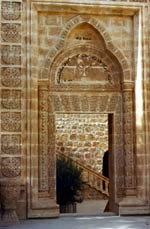 |
| The
region of Tur Abdin in southeast Turkey is rich in historic
buildings. (photo: Chuck Todaro) |
Summer is a busy time of
year for the villagers. From the break of day to evening the entire
village empties into the fields – the mayor included. He too has to look
after his plot of land. In his spare time, he can be found at the church
teaching Aramaic to children or acting as a tour guide. Last summer, the
village had nearly 4,000 guests – and for these hospitable people that
does not just mean pointing out landmarks and answering questions.
Hospitality often means offering lunch or even a place to sleep.
The village’s schoolhouse is
in a small rectangular building next to the church. Its one room is where
Hah’s 17 children, from grades one through five, are taught.
“This is not as difficult as
you might think,” said the school’s teacher. Yet he does complain of the
few materials the Turkish government gives students, forcing children to
share books.
After graduating from
primary school, village boys board at a monastery and attend middle and
high school in either Midyat or Mardin. But for the majority of girls,
education ends with fifth grade.
Shaking his head Mr. Dogan
admits that, after this year, his daughter, Victoria, will be staying home
with her mother.
“I am afraid for her,” he
sighed. When asked what could happen he shoots back: “Who knows. I just
hope it will be better in the future for the younger ones.”
The fear he and most
Christian villagers feel for their children stems from a history of
marriageable girls being kidnapped.
Though Mr. Dogan will not
utter the word, the village priest, Father Gabriel Akyuz, does.
“Kidnapping,” he blurted out, but only after checking to see that no one
was listening. “It has happened before. Yes, 20 years ago, 15, 13 years
ago. We are now very aware.”
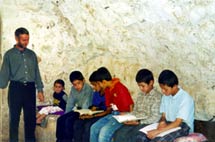 |
| Syriac
Christian children are the hope of the future. (photo: Chuck
Todaro) |
Archdeacon Melfono Gulten
from Mar Gabriel Monastery acknowledges that kidnappings took place but
said: “It is a fear that belongs in the past. I think the teachers are
better trained now and this new generation is a more understanding one.
But it needs time.”
And other village children
seem to agree – including Christians Hazni and Nahir, both 17, who attend
Midyat high school. They say that they have never had a problem in school
caused by their religion. They even seemed a bit surprised by the
question.
From the outsider’s point of
view this is an exciting period for the Syriac Christians of Tur Abdin.
But those living there feel frightened; they find themselves at a
crossroads. They are not really sure which road to take, not knowing where
it will lead.
“I wish to be optimistic
about the future, but that is not reasonable,” said one church official.
“All the decision-making is essentially out of our hands and we find
ourselves living a wait-and-see reality.”
“There is nothing certain
about our future,” added Mr. Dogan.
“It is an open book.”
Chuck Todaro reports from
the Middle East and Eastern Europe.
www.cnewa.org